
Banks dory
Encyclopedia
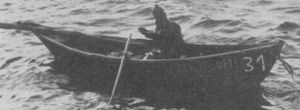
Dory
The dory is a small, shallow-draft boat, about long. It is a lightweight and versatile boat with high sides, a flat bottom and sharp bows. They are easy to build because of their simple lines. For centuries, dories have been used as traditional fishing boats, both in coastal waters and in the...
. They were used as traditional fishing boats from the 1850s on the Grand Banks
Grand Banks
The Grand Banks of Newfoundland are a group of underwater plateaus southeast of Newfoundland on the North American continental shelf. These areas are relatively shallow, ranging from in depth. The cold Labrador Current mixes with the warm waters of the Gulf Stream here.The mixing of these waters...
of Newfoundland. The Banks dory is a small, open, narrow, flat-bottomed and slab-sided boat with a particularly narrow transom
Transom (nautical)
In naval architecture, a transom is the surface that forms the stern of a vessel. Transoms may be flat or curved and they may be vertical, raked forward, also known as a retroussé or reverse transom, angling forward from the waterline to the deck, or raked aft, often simply called "raked", angling...
. They were inexpensive to build and could be stacked or nested inside each other and stored on the decks of larger fishing vessels which functioned as mother ship
Mother ship
A mother ship is a vessel or aircraft that carries a smaller vessel or aircraft that operates independently from it. Examples include bombers converted to carry experimental aircraft to altitudes where they can conduct their research , or ships that carry small submarines to an area of ocean to be...
s.
Banks dories have long overhangs at the bow
Bow (ship)
The bow is a nautical term that refers to the forward part of the hull of a ship or boat, the point that is most forward when the vessel is underway. Both of the adjectives fore and forward mean towards the bow...
and stern
Stern
The stern is the rear or aft-most part of a ship or boat, technically defined as the area built up over the sternpost, extending upwards from the counter rail to the taffrail. The stern lies opposite of the bow, the foremost part of a ship. Originally, the term only referred to the aft port section...
which helps them lift over waves. There were one-man and two-man versions. The larger ones (12 ft along the bottom or more) could be fitted with sail
Sail
A sail is any type of surface intended to move a vessel, vehicle or rotor by being placed in a wind—in essence a propulsion wing. Sails are used in sailing.-History of sails:...
s and a tiller
Tiller
A tiller or till is a lever attached to a rudder post or rudder stock of a boat that provides leverage for the helmsman to turn the rudder...
. The dories became more stable in rough weather when they were loaded with about half a ton of catch.
Production
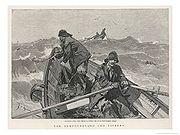
Lunenburg, Nova Scotia
Lunenburg , is a Canadian port town in Lunenburg County, Nova Scotia.Situated on the province's South Shore, Lunenburg is located on a peninsula at the western side of Mahone Bay. The town is approximately 90 kilometres southwest of the county boundary with the Halifax Regional Municipality.The...
; Shelburne, Nova Scotia
Shelburne, Nova Scotia
Shelburne is a town located in southwestern Nova Scotia, Canada. It is the shire town of Shelburne County.-History:-Settlers:...
and both Portland and Bremen, Maine. Salisbury alone had 7 shops producing between 200 and 650 boats a year. The firm of Higgins and Giford of Gloucester advertised in 1886 that it had built over 3,000 dories in the preceding 13 years. Founded in 1793, Lowell's Boat Shop of Amesbury Massachusetts is the oldest continuously operating boat shop in United States. It the first to build these boats in large numbers and excelled at their mass production. In the year 1911 Lowell's Boat Shop produced 2029 dories, averaging 7 dories a working day. A National Landmark and working museum, Lowell's Boat Shop continues to build its dories and skiffs in the Lowell tradition to this day.
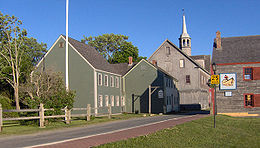
Nova Scotia
Nova Scotia is one of Canada's three Maritime provinces and is the most populous province in Atlantic Canada. The name of the province is Latin for "New Scotland," but "Nova Scotia" is the recognized, English-language name of the province. The provincial capital is Halifax. Nova Scotia is the...
, the towns of Lunenburg and Shelburne maintained a rivalry in mass production of dories. A distinction emerged in 1887 with the use in Shelburne of "dory clips", metal braces used to join frames, versus the more expensive but stronger natural wood frames used in Lunenburg dories. The John Williams Dory Shop in Shelburne was one of several Shelburne factories mass producing dories. It is now the Dory Shop Museum, operated by the Nova Scotia Museum
Nova Scotia Museum
Nova Scotia Museum is the corporate name for the most decentralized museum in Canada - 27 museums across Nova Scotia, including over 200 historic buildings, living history sites, vessels, specialized museums and close to a million artifacts and specimens...
and continues to produce banks dories for local and visiting customers.
Mother ships
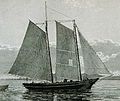
Schooner
A schooner is a type of sailing vessel characterized by the use of fore-and-aft sails on two or more masts with the forward mast being no taller than the rear masts....
s, and used for handlining cod
Cod
Cod is the common name for genus Gadus, belonging to the family Gadidae, and is also used in the common name for various other fishes. Cod is a popular food with a mild flavor, low fat content and a dense, flaky white flesh. Cod livers are processed to make cod liver oil, an important source of...
on the Grand Banks
Grand Banks
The Grand Banks of Newfoundland are a group of underwater plateaus southeast of Newfoundland on the North American continental shelf. These areas are relatively shallow, ranging from in depth. The cold Labrador Current mixes with the warm waters of the Gulf Stream here.The mixing of these waters...
. Prior to the introduction of Banks dories, fish were caught with handlines from the mother ship alone. Weather permitting, the dories were launched early each day with one or two crew and bait from previous catches. During the day they would return several times to the mother ship and unload their catch.
The barquentine
Barquentine
A barquentine is a sailing vessel with three or more masts; with a square rigged foremast and fore-and-aft rigged main, mizzen and any other masts.-Modern barquentine sailing rig:...
, Gazela Primeiro, while not a schooner, was one of the last of the dory mother ships. She had a long association with dories and the Grand Banks cod industry and made her final voyage as late as 1969.
Banks dories have been capable of surviving long voyages, some unintentional, when the fishermen became separated from their mother ships. One of the more famous adventures was by Howard Blackburn
Howard Blackburn
Howard Blackburn was a Gloucester, Massachusetts fisherman, born in Nova Scotia. Despite losing his fingers at sea in 1883, he prospered as a Gloucester businessman...
, who survived 5 days in the North Atlantic in January.
A Banks dory is seen in Winslow Homer
Winslow Homer
Winslow Homer was an American landscape painter and printmaker, best known for his marine subjects. He is considered one of the foremost painters in 19th century America and a preeminent figure in American art....
's painting The Fog Warning.
Other uses
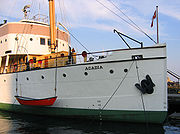
Cape Islander
A Cape Island style fishing boat is an inshore motor fishing boat found across Atlantic Canada having a single keeled flat bottom at the stern and more rounded towards the bow. A Cape Island style boat is famous for its large step up to the bow....
. In recent times, the history and iconic look of banks dories have made them popular for amateur boat builders and some recreational boaters

